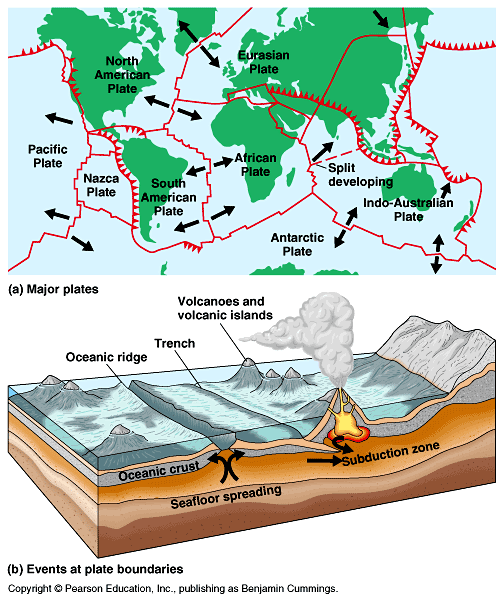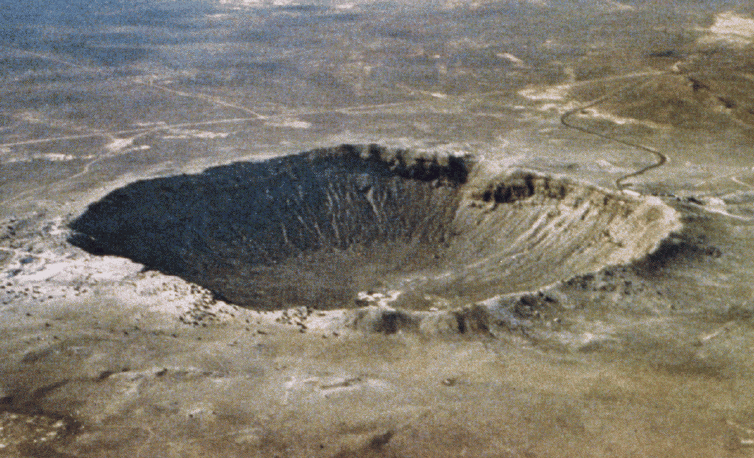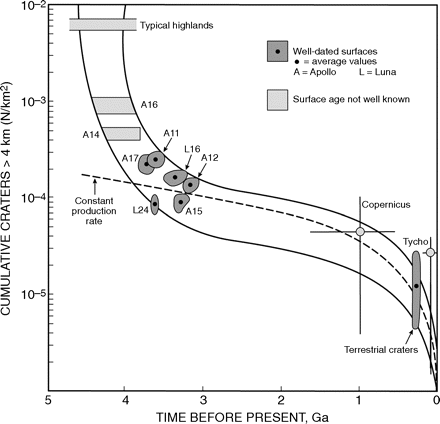|
Surface Features of the
Terrestrial Planets |
The surface features of Terrestrial planets may be young or old based
upon whether the planet shows ongoing active geology. Young
surfaces are geologically active while old surfaces are not. In the latter
case, when active geology disappeared determines what processes determine
the appearance
of the current surface of the planet.
Today, the appearances of the Terrestrial planets
differ strongly. We look at the Earth and the Moon in detail but,
this time, we will also look at Venus, and Mars as well.
In terms of their surfaces, the
Terrestrial planets may be divided into two groups: (1) Venus and Earth; and
(2) Mercury and the moons. Mars is intermediate between the two groups. The
division is based on the amount of ongoing evolution and appearance
of the surface features of the planets
(which is determined by the size of the planet).
I. THE MOON (GROUP 2)
A. Surface Features
(1) A neat animation shows the
rotating Moon put together using
Clementine
images. (2) Two pairs of images are shown below. The top two are photographs of
the Moon, one of the near side (the Earth-facing side) and one of the far side
(the side never presented to us). The Moon rotates at the same rate as it
orbits the Earth so that it always presents
the same face to the Earth. The
second pair of images are relief maps (topographic maps) for the near side
and far side of the Moon.


|
The Moon is divided into two types of
terrain:
-
maria, the lightly cratered,
dark-colored lowland
basins which cover 15 % of the lunar surface.
The maria are
large basins (old impact craters) which have
been filled in by
large lava flows. Their surfaces are dark and smooth with little
evidence of cratering. The largest impact basin on the Moon is the
South Pole-Aitken basin.
It is 2,500 kilometers in diameter! The circumference
of the Moon is 11,000 kilometers! The South Pole-Aitken basin
is 4.2-4.3 billion years old.
- highlands,
the light-colored, heavily cratered
regions which cover 85 % of the lunar surface.
Because of their heavy cratering, the highland regions are inferred to
be ancient while the lightly-cratered maria
are inferred to be young (younger).
The lunar mountains
in the highland regios are produced by the large impacts
uplifting the terrain.
They are not formed as
are mountains on Earth, that is, they are not formed
through crutal motions driven by geologic forces (
e.g., on Earth driven by motion of lithospheric plates).
Features similar to those found on the Moon are also seen on Mars and Mercury.
|
The far side of the Moon is similar to the near
side of the Moon in terms of cratering rate. There are some differences
in cratering though.
(1) There are fewer
maria on the far side of the Moon, probably
because of the asymmetry in the crutal thickness of the Moon.
(2) Recent studies find
that impact basins are smaller in size on the far side of the Moon
than those on the
Earth-facing side of the Moon. What are possible
implications of this result?
Crater Origin:
The craters on the Moon and
on most other Terrestrial planets (see
Mercury)
were produced by impacts and not by volcanism. The Lunar craters are
low-lying, below sea-level, not like the caldera of volcanos.
The primary factors that
affect crater size are the mass of the impacting object, the speed with
which the objects strikes the ground, and the local geology (type of rock).

|
Copernicus (93 km) and Tycho (85 km) are fairly young craters on the Moon,
800 million years and 108 million years old, respectively.
Suppose the objects which produced Copernicus and Tycho on the Moon
had actually struck the Earth, would the craters on Earth be larger or
smaller than Copernicus and Tycho?
|
B. Lunar Chronology
The relative ages of different regions on the Moon are easy to determine.
If we count the number of crators in different regions, we infer
- The higher the crater density, the older the region
- The lower the crater density, the younger the region
So, for the Moon, we knew early on that the heavily cratered highland regions
were older than the lightly cratered maria.
After we went to the Moon, we could take the next step. We could find the
chronology for the Moon, in that we could determine actual ages in terms of
years for features, not just whether they were
younger or older. We could do this because we have
been there, seen it. This allowed us to
gather rock samples from various terrains on the Moon and
determine their ages using
radioactive age dating.
This allowed us to set a firm
timeline for the evolution of the lunar surface features
and to set the chronology for lunar cratering.
This is valuable
because the Lunar cratering history is, presumably, the same
as the the inner Solar System planets cratering history.
The cratering density has, so far, been the most useful way to judge
ages of features on Mars.
Lunar Chronology
Using radioactive age dating, Moon rocks were found to be:
- Mare Basalt: - 3.1 to 3.8 billion years old
- Highland Breccia: - 3.8 to 4.0 billion years old
- Highland Anorthosite - proved difficult for absolute dating; but are
estimated to be 4.4 billion years or older.
Given these ages, can construct the lunar chronology shown
to the right. The abbreviation, Ga, is 1 billion
years.
|

|
C. Cratering Rate
We think about how this works below but first, let me point out that
because the Moon has an old surface, and so the cratering history goes back
further than it does on the Earth.
The left figure shows the cratering density for the Moon and
how it has changed over the years. The first step is to simply count
the numbers of craters in some region, say a mare.
For mare, we find that there are relatively few
craters, mare are definitely younger than the
highland regions. Next, find the ages of the craters in the mare.
The ages measured for the craters then tell us the rate at
which craters were formed in the mare. In this way
we found that mare fairly old, between 3.2 and
3.8 billion years or so, despite being lightly cratered. This shows us that
the cratering rate for the Moon was low over the lifetime of the
mare. Looking at other regions on the Moon, we can
get the cratering rate for nearly the entire lifetime of the Moon.
The crater counting is consistent with a cratering rate on the Moon
that has been slow and steady for the past
3 billion or so years. Around 4 billion years ago, there isn't a jump,
but it was around this time the the large impact basins that formed the
maria were made. Apparently an increased rate of large impactors happened
at this time, the so-called Late Heavy Bombardment.
Not apparent in the plot, but there was also a
jump in the cratering rate around 290
million years ago when the rate jumped by around a factor of 3.
We can do a similar exercise for the Earth. Surprisingly, studies
suggest that the cratering history for land masses on Earth
is complete for craters larger than 6 km over the last billion
years or so. This result
says that we have found nearly all of the craters on
the Earth with diameters larger than 6 km over this time.
Craters smaller than 6 km in diameter are destroyed by erosion and
geological effects. Older craters suffer erosion and affects due to
geology. So, although this result is great, it could be better in that
it doesn't reach back to Late
Heavy Bombardment times.
The cratering rate for the Earth is then

The shape of the plot is similar to that for the Moon suggesting we share
a common source for the impactors.
A dinosaur killer occurs roughly every 100 million years or so. The
dinosaur killer produced the Chicxulub crater
65 million years ago.
II. GEOLOGIC ACTIVITY ON EARTH (GROUP 1)
The most massive Terrestrial planets, Earth and Venus,
are likely to show
active geologies.
Mars may show current or recent geological activity as well.
Mercury and
the Moon are probably dead from a geological standpoint. The sorts of
geology we
expect are volcanism and crustal motion, both
manifestations of the
fact that the interiors of the planets are hot.
A consequence of
geological activity (and wind and water erosion on the
Earth) is to produce a relatively young surface.
The surface of
Venus is around 300-800 million years old, while the majority of the Earth's
surface features are much younger. For example,
- Ocean basins are < couple hundred million years old
-
Hawaiian Islands, island chain,
~ millions of years old
- Grand Canyon (cut by the Colorado River) < 10 million years old
- Himalayas,
Andes mountain ranges < tens of millions of years old
These ages are to be compared to the Lunar Chronology where the youngest
features, the maria, are older than 3 billion years.
Geologic Activity on the Terrestrial Planets? The Earth shows plate
tectonics. In addition to showing vertical crustal motion, the Earth
has a segmented lithosphere that moves horizontally. This proves to be
crucial for how our atmosphere evolves. It is thus of interest to know
if other Terrestrial planets show Plate Tectonics.
Venus and Mars both show plenty of geologic activity but neither shows
compelling evidence for Plate Tectonics. For some reason both planets do
not have segmented lithospheres, their lithospheres are single solid pieces.
(1) Venus's lithosphere may not be brittle as Earth's because Venus is hot. Even
if Venus had a segmented lithosphere it might still not have plate tectonics
because it is so dry. On Earth, convection
drives plate tectonics and water acts as lubrication in subduction zones.
(2) Mars's lithosphere is thicker than is the Earth's (likely because Mars
is smaller and thus cools faster than does Earth).
Consequently, Mars's lithosphere may not break as
easily as does the Earth's.



















